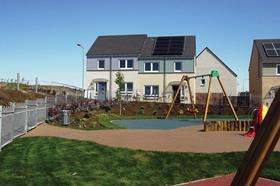Government estimates cost of introducing ŌĆśallowable solutionsŌĆÖ to housebuilding industry could be as much as ┬Ż224m per year

The government plans to cap the amount of money that housebuilders will have to spend to meet the zero-carbon homes standard from 2016 through off-site carbon saving measures.
The government said the cost of providing ŌĆ£allowable solutionsŌĆØ - where housebuilders undertake actions outside of the building itself to contribute towards meeting their zero-carbon obligations, such as renewable energy schemes for the community, or paying into a fund focused on abating carbon ŌĆō would be between ┬Ż36 per tonne CO2 and ┬Ż90 per tonne CO2.
The consultation estimated the central option of ┬Ż60 per tonne CO2 would add up to ┬Ż2,123 to the price of a detached house.
The impact assessment of the policy estimated introducing allowable solutions would cost the industry a maximum of ┬Ż224m per year.
However, it said this was an ŌĆ£overestimateŌĆØ and the burden was likely to be less than this.
But it did say the policy constituted a ŌĆ£substantialŌĆØ additional regulatory burden under the governmentŌĆÖs rule of introducing only one regulation on industry for every two removed.
It also said four routes for implementing allowable solutions were under consideration:
- Requiring all carbon to be abated onsite or through connected networks
- Undertaking work offsite either to improve existing buildings or build ne energy generating capacity
- Paying another firm to do work to offset carbon emissions from the building
- Paying into a fund to build off site measures to abate carbon. But the government said it favoured keeping the fund focused on abating carbon a national scheme because the administrative cost of setting up local authority schemes would be too high.
Paul King, chief executive of UK Green ║├╔½Ž╚╔·TV Council, said the proposals were ŌĆ£sensibleŌĆØ.
He added: ŌĆ£We believe the price of allowable solutions should be set to encourage community level solutions first. We also welcome the proposal that allowable solutions should also be available for non domestic buildings ŌĆō something weŌĆÖve consistently called for.
The consultation is open until 15 October 2013.
Roger Humber, strategic policy advisor at the House Builders Association, said the whole zero carbon policy was ŌĆ£never remotely feasibleŌĆØ following the credit crunch and needed changing.
ŌĆ£The combined elements of this policy of fabric and carbon compliance and allowable solutions is going to put small house builders out of business because itŌĆÖs too complex,ŌĆØ he said.
He added that it was ŌĆ£not acceptableŌĆØ to change building regulations in 2014 and then again in 2016.
David Bownass, sustainability director at WSP in the UK, said the final policy should be shaped to promote the most effective way of reducing carbon.
He added: ŌĆ£In thinking about this we should also consider the end consumer, the home owner. A future zero carbon home that addresses all the carbon emissions on site through PV will have a very significantly lower operating cost to one where the builder just met the carbon compliance threshold and bought out the residual carbon emissions.ŌĆØ



























1 Readers' comment